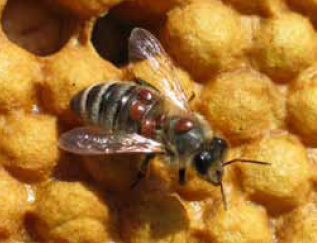A new study from Univ. MD shows that imidacloprid does not significantly harm honey bee colonies at real-world dosage levels.

The results showed that imidacloprid residues became diluted or non-detectable within colonies due to the processing of beebread and honey and the rapid metabolism of the chemical. Imidacloprid exposure doses up to 100 μg/kg had no significant effects on foraging activity or other colony performance indicators during and shortly after exposure. Diseases and pest species did not affect colony health but infestations of Varroa mites were significantly higher in exposed colonies.
In a recent presentation given by Dennis vanEngelsdorp at the Eastern Branch of the Entomological Society Meeting on 16 March, 2015, vanEngelsdorp clearly identified the importance of the Varroa mite as a significant stress to honey bee colonies. The mite acts as a vector for viral transmission that can dramatically change bee behavior, while feeding directly on developing and mature bees by the parasitic mite reduces overall colony survival.“Everyone is pointing the finger at these insecticides,” said Galen Dively, emeritus professor of entomology at the University of Maryland and lead author of the study. “If you pull up a search on the Internet, that’s practically all anyone is talking about. This paper says no, it’s not the sole cause. It contributes, but there is a bigger picture.”
Insecticides in the neonicotinoid class are chemically derived from nicotine. In tobacco and other related plants, nicotine acts as a deterrent by poisoning insects that bite the plants. In fact, nicotine used to be commonly used as an insecticide, but it has fallen out of favor because it is highly toxic to humans and breaks down rapidly in sunlight. Neonicotinoids have been engineered specifically to address these shortcomings.
“A lot of attention has been paid to neonicotinoids, but there isn’t a lot of field data,” said Dennis vanEngelsdorp, an assistant professor of entomology at UMD who was not involved in the study. “This study is among the first to address that gap. It’s not surprising that higher levels will hurt insects. They’re insecticides after all. But this study is saying that neonicotinoids probably aren’t the sole culprit at lower, real-world doses.”
Read the article in Entomology Today
Read the original article: Assessment of Chronic Sublethal Effects of Imidacloprid on Honey Bee Colony Health
Galen P. Dively, Michael S. Embrey, Alaa Kamel, David J. Hawthorne, Jeffery S. Pettis. PLOS Published: March 18, 2015 DOI: 10.1371/journal.pone.0118748

